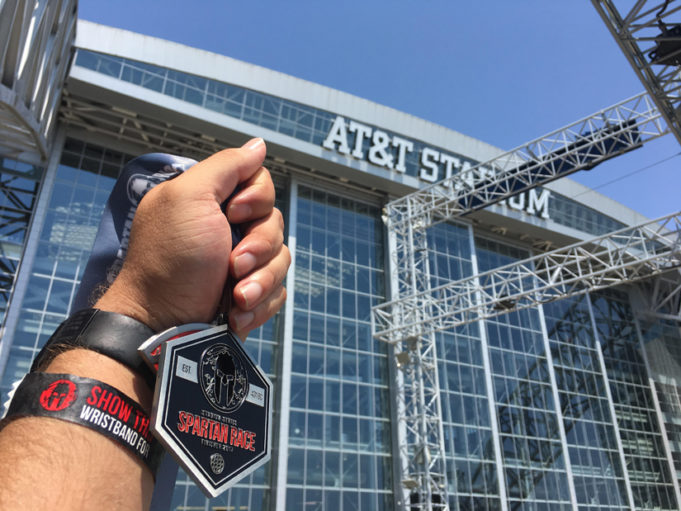Last Saturday, I decided to test my lungs, legs, and longevity and join more than 4,200 adventure seekers to discover the allure of Obstacle Course Racing (OCR). Most people go to AT&T Stadium to “spectate” gridiron warriors, but on this day it was all Sparta.
The Spartan Race is the brainchild of Andy Weinberg, Julian Kopald, and Joe De Sena, who together started a series of OCR in 2007 called Peak Races. The first Spartan Race was held in 2010 in Vermont, and the name is derived from Kopald’s pet llama, Spartan. Reebok became the event’s title sponsor in 2013.

The AT&T Stadium race is distinctly different from other races in the Spartan Series. It’s part of the Stadium Series, so some elements that are common to the advertisements and branding of the race are absent: Mud, barbed wire, and fire jumping would be out of place among luxury boxes and nacho concession carts. As a replacement for these obstacles, there are stairs, stairs, and then some more stairs after that.
First things first: You have to pay to play. The Spartan Race comes with a steep price tag for athletes accustomed to 5K runs or bike rallies. The registration for the afternoon timeslot was $95, plus a mandatory $14 for insurance (always a good sign), along with taxes from the City of Arlington. A Memorial Day coupon helped bring the cost down 20 bucks, but the final tag was approximately $107, plus $15 to park in the shadows of Jerry’s World.
For all that cash, competitors don the signature headband with printed participant number. Each racer is given a wristband with a tracking device that records time spent on the course. During registration, racers can designate phone numbers to receive updates as they progress. My mother and wife both enjoyed updates as obstacles were completed and being notified when the race finished. Finishers receive a high quality medal along with a “pie” piece to construct a larger medal when they complete three Spartan races of different distances within a calendar year. T-shirts are given to finishers, of course, but people love the perk of pictures more than that. The Spartan Race is unique in giving racers the opportunity to download free photos of themselves on the course.

The race was essentially a stadium tour for the brave or the unbalanced. The sprint distance Spartan Race is between 3 and 5 miles, and it mixes in more than 20 obstacles. The experience will be a joy for fans of Ninja Warrior, Crossfit, and Family Double Dare. Participants handle jump ropes with a climbing rope, sandbag carries through the stairs, vaulting over walls, a rope climb, a spear throw at a target, cement block carries, and then hundreds of stairs on your feet and bear-crawling. Some obstacles are more difficult than others and will vary wildly depending on the athlete. Being husky myself, I enjoyed lugging around cement blocks and hoisting a heavy sandbag with a rope. The lighter athletes fared better at rope climbs and swinging between rings. The penalty for not completing an obstacle is 30 burpees, so in theory, anyone can finish. But not everyone can finish fast.
The first athletes to attempt the course are the elites, Spartan veterans who aren’t worried about finishing but are competing for prize money. The remainder of the day sees 15 weekend warriors being released into the course every 30 seconds.
After I got over the initial sticker shock, the AT&T Stadium Spartan Sprint was intensely satisfying. The entire experience felt like a fitness expo complete with families, teams, weird costumes, and a DJ and announcer who kept the stadium feeling lively throughout the day. The next local Spartan Race is Saturday, Oct. 28, at Rough Creek Lodge and Resort in Glen Rose. Don’t expect to stay as clean and dry when race directors aren’t restricted by stadium boundaries.












